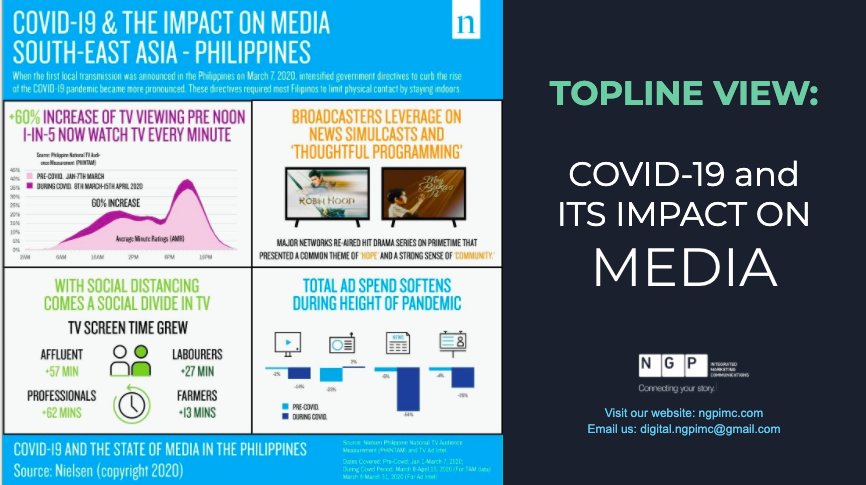COVID-19 has caused a shift in nearly every industry, including the media and digital marketing space.
According to a Nielsen report on the impact of COVID-19 on the media in the Philippines, four major shifts stood out:
- A 60+% increase of TV viewing (whether on TV or online TV)
- A surge in ‘thoughtful programming’ that convey messages of hope
- An increase in TV viewing time among the upper & middle classes (with little to no changes in viewing time among the blue collar workers), and;
- On the advertiser side, a drastic change in ad spend
Let’s delve into each of these shifts a bit.
Increase in viewership, more so for Digital
Filipinos check the television for news multiple times a day, touting this as their most trusted news source. Right behind television as a trusted source is, unsurprisingly, social media. A Global Web Index study reported almost a 25% increase in social media consumption, meaning that if people weren’t already on their social media platforms enough, that has increased even more now.
This could be owing to the fact that most, if not all, news and information are floating around the digital space. Even televised streams are being mirrored online on social media platforms, putting all these sources of information under one mobile application or two for easy consumption.
The emerging habit of validation
Information-seekers are also spending more time looking into their news sources to double-check if information is indeed accurate, or at least comes from a source that they deem trustworthy.
People find these two digital sources – television and online/social media — more reliable than word-of-mouth news and information from family and friends. They are also more active in engaging in COVID-19-related content online. An example would be local news site Rappler, which saw a 60% increase in local readership from outside the Metro.
Direct sources for such content, like the World Health Organization website, are deemed by readers as the top most reliable source, followed by local news channels that have both televised and online news on their websites, then mirrored on their respective social media platforms.
Surprisingly, radio has become a reliable news source, with people tuning in to programs such as Teleradyo for its convenience and timeliness. Expert reliable blog posts are also becoming popular. Interestingly, news on newspapers have not ranked towards the top reliable news sources. This is likely because people’s exposure to news on this medium is close to none, not because the news on paper isn’t reliable.
Thoughtful programming
So what content are people looking for these days?
The same Global Web Index study found a 70% increase in interest for COVID-19-related content, particularly from the millennial generation, followed by increased interest in new movies and healthy recipes. Gen X’ers and Boomers have also shown an increased interest in COVID-19-related news, at 69% and 54% respectively. Gen Z’ers seem to prefer to busy themselves with new music.
Brands have shifted from bricks to clicks, ensuring that they stay relevant throughout the entire pandemic. They’ve also started to look into ways to appeal to the change in their customers’ media consumption. More brands and companies are putting out their own key opinion leaders to weigh in on the current situations in the country, and their online organic content more often than not include thoughtful messages of encouragement, hope, community and togetherness, calls for change, and the like.
Social class shift
More of the affluent classes and the professionals who have started working from home, upon community quarantine protocols, have increased their online TV and TV viewership by more than an hour. As mentioned, their content of choice are COVID-19 news and thoughtful programming that convey feel-good themes. They are also keen on health information, practical tips, and stories of coping, hope, and survival.
On the other end of the social class spectrum, the manual laborers and workers, and those who work on a no work, no pay scheme have seen no shift in their television consumption, with increases only clocking in at less than 30 minutes at most.
Advertiser shift
Ad revenue has dropped drastically for print media (newspapers and magazines) by a whopping 54% as advertisers relegate their budgets towards digital platforms more visible to their target audiences. Television and out-of-home (OOH) advertising has also skidded to a halt and declined by as much as 25%.
Interestingly, radio ad spend has increased by 25% or so over the last few months. This could be owing to the fact that radio advertisements are quite easy to produce, as opposed to television commercials that would require physical touchpoints to shoot.
Likewise, as people look for more reliable, feel-good content, marketers and advertisers are looking into more human-centric, real-life-story-based advertising to get the appeal of their market.
With these new developments, digital media has really propelled itself as the mainstream platform for information.
How should your company communicate now?
As a digital PR and IMC agency, NGP IMC recommends that you capitalize on your online presence and maximize every digital touchpoint in ways that you can’t for physical touchpoints.
Here’s an easy acronym for you to remember as you connect your stories to your audience’s interests: Make your content S.E.R.V
S is for scannable
To make your online presence felt, you should be able to write for scanners, not readers. Keep in mind that your audience has hundreds more varieties of content to go through, so to stay relevant, pack as much information as you can into your content’s points of entry. A bit of fun and wit in your headlines will also help draw readers in.
E is for engaging
Once you’ve earned your audience’s attention, you’ll also have to keep them engaged. In general, people love having something to say about their favorite brands. They tend to engage with brands or products they like, expressing their feelings and satisfaction with the products and services offered. They also like commenting on social media pages, so as a good practice, always be able to acknowledge their engagement by replying to and liking their comments. Ensure also that your replies to any of their direct messages are timely, and you keep an engaging conversation going!
R is for rankable
If your business is new to the online world, know that in order for you to reach your readers with your meaningful content, Google has to find you meaningful, too. Being recognized and ranking high on search engines are integral steps in having a strong online brand presence. Regardless of the nature of business, ranking in at least the first page of search engine results is a necessity, so invest in good SEO and SEM!
V is for variable
Finally, your audience would appreciate a bit of variety. Don’t just put out one form or style of content forever. Explore new possibilities and learn which formats work for your audience and which ones flop. Partner with online news sites and blogs. Have your company host online media engagements with key opinion leaders on relevant and timely topics. Host online broadcasts on social media to appeal to a wider market. Post various content in video or photo format, or try polls, notes, and others.
The COVID-19 pandemic has definitely caused a shift in all industries but the new normal way of doing things is upon us. We hope you find these tips valuable!
Now the question is, as a brand that’s trying to reach out to its target customers: how are you connecting your stories?
Does your business need more information about the current media landscape in the Philippines? Get on a FREE virtual presentation and discovery call with NGP IMC, an integrated marketing communications agency in the Philippines.
Contact us at digital@ngpimc.com to schedule a meeting.



Leave a Reply